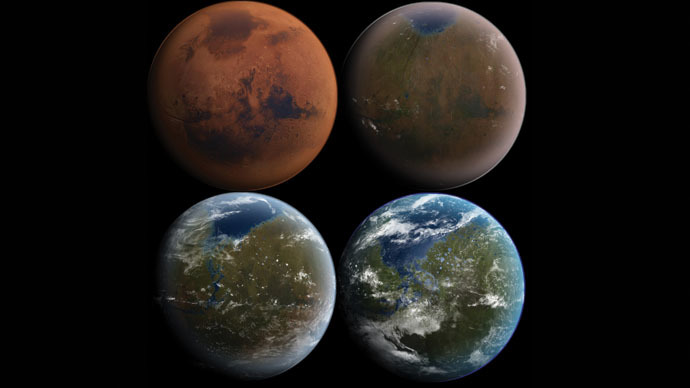DARPA hopes to terraform Mars with human-engineered organisms

Mars may look like an inhospitable and barren landscape, but a new program underway at the Pentagon’s advanced research division is looking to create engineered organisms that can eventually transform the Red Planet into something more Earth-like.
If humans are ever to live on Mars without being confined inside of man-made structures, the planet’s climate and surface would need to be radically altered. It features potentially dangerous planet-wide dust storms, low gravity, and its thin atmosphere, plus increased distance from the sun, makes it an especially cold place for any humans to settle – the average temperature is -50 degrees Celsius (-122 degrees Fahrenheit), according to NASA.
READ MORE: Impact glass found on Mars may be key to discovering life, scientists say
To change that, humanity may be able to engineer brand new organisms that can not only survive the harsh Martian climate, but also begin changing it in important ways. As described in a report by Vice’s Motherboard, that could mean introducing genetically engineered plants, algae and other organisms that could start heating up the planet and possibly even thicken its atmosphere.
This process of intentionally changing a planet’s climate to support human life is known as terraforming, and the Pentagon’s Defense Advanced Research Projects Agency (DARPA) said this week it’s already laying the foundation for such organism engineering.
“For the first time, we have the technological toolkit to transform not just hostile places here on Earth, but to go into space not just to visit, but to stay,” Alicia Jackson, the deputy director of DARPA’s Biological Technologies Office, said at a biotech conference on Monday, as quoted by Motherboard.
Specifically, Jackson said that DARPA and its partners have designed the “Google Maps of genomes.” Using this system, scientists will be able to quickly sift through the genomes of numerous organisms that already exist on Earth. They will also be able to quickly identify specific genes and pinpoint where they are located on the genome of an organism, potentially allowing researchers to mix and match genes from multiple organisms in order to generate a brand new form of life.
“There are anywhere from 30 million to 30 billion organisms on this Earth. We use two right now for engineering biology,” Jackson said Monday. “I want to use any organism that has properties I want – I want to quickly map it and quickly engineer it."
READ MORE: Scientists emerge from 8 months of simulated life on Mars
“With this, the goal is to, within a day, sequence and find where I can best engineer an organism,” she added.
Of course, any plan to engineer organisms and ship them off to Mars for terraforming purposes is a long way from coming to fruition. As DARPA’s research progresses, it hopes to test these capabilities right here on Earth. According to Motherboard, Jackson said these synthetic organisms could be deployed in the wake of a natural or man-made disaster, where they would be able to survive in tough environments and eventually restore the area back to a pre-disaster climate.
If all goes well on Earth, then humans could set their sights on making even more dramatic changes in space.












